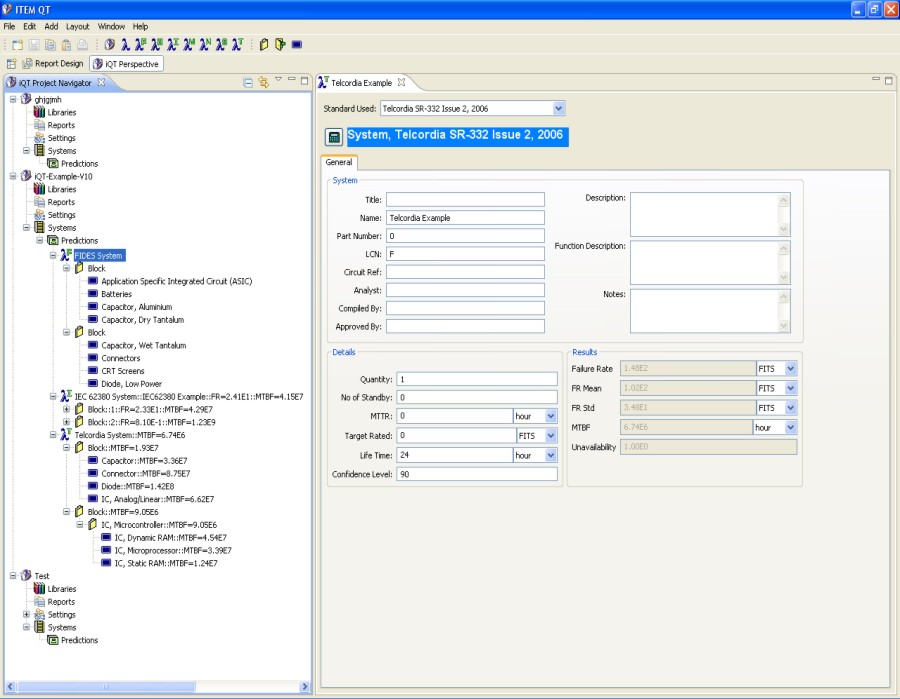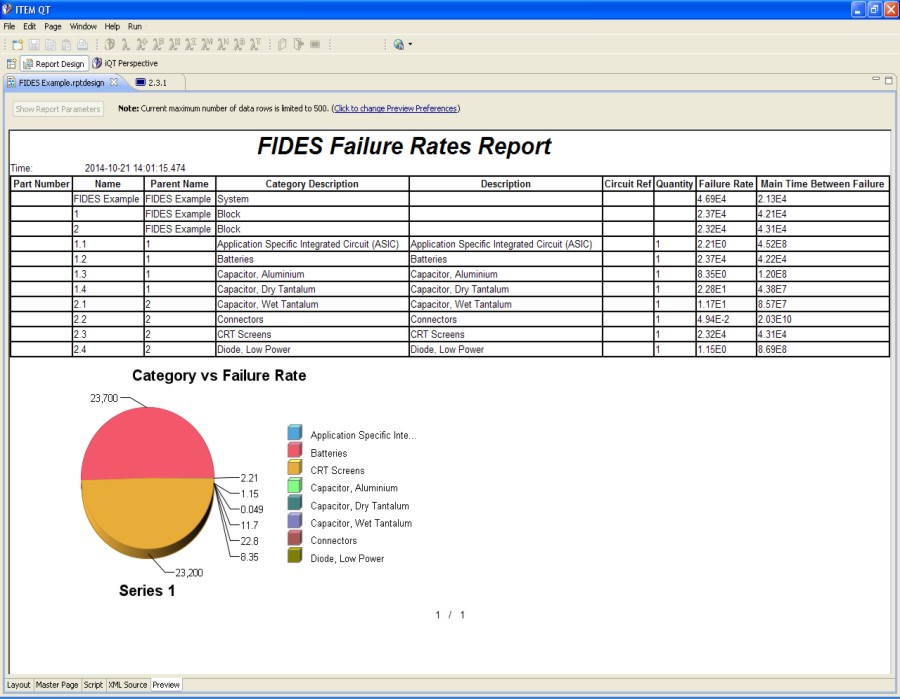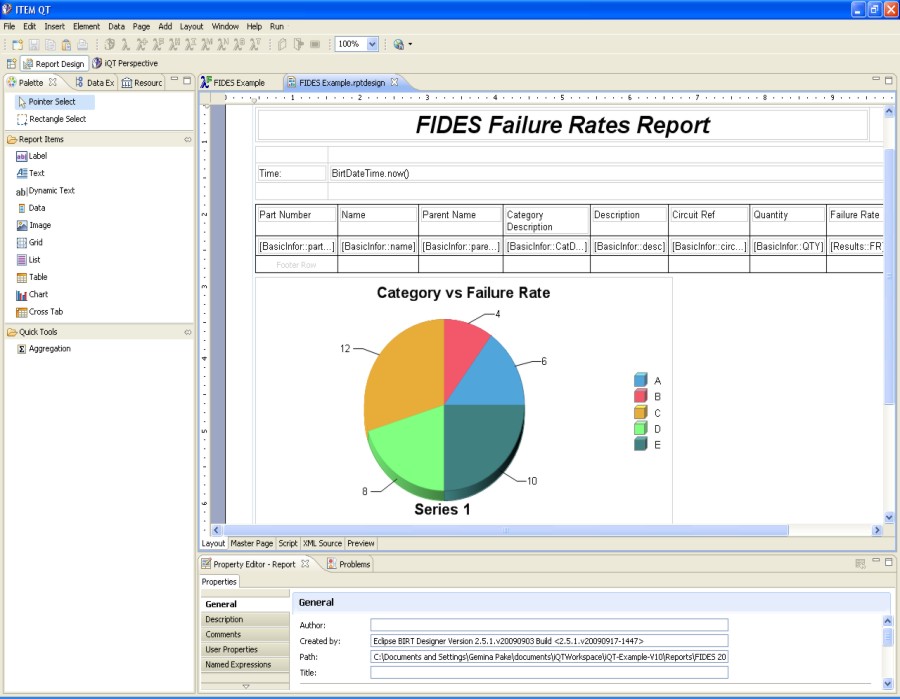
ITEM QT Software
Reliability, Safety and Risk Assessment Software
The latest release from ITEM Software is an extraordinary collection of new capabilities that provides a customizable, cross-platform, multi-user, open frame-work. Built on proven and recognized analysis engines, ITEM QT (iQT) is a revolutionary approach to reliability, safety, and risk analysis software tools. With iQT, you are no longer limited by the technology choices of software vendors or chained to infrastructure requirements of their products. Continue reading to learn more about the iQT design that provides a framework to suit all of your needs.
ITEM Software continues to build and deliver reliable, defensible, and innovative tools your industry requires. Over the years, we have heard from many users in a variety of industries – analysis tools need to be more open and extensible. In developing this new tool, ITEM Software has taken into consideration that not every company or situation has the same requirements and capabilities.
The preliminary modules fully released and currently available are the reliability prediction standards :
- FIDES 2009, IEC 63142 ED1 (Electronic)
- Telcordia SR-332 (Electronic)
- IEC 62380, UTE C 80-810 (Electronic)
- HRD 5 (Electronic)
- Siemens SN 29500 (Electronic)
- Generic Standard (Fully Customizable)
- NSWC-06/LE10 (Mechanical)
- NSWC-98/LE1 (Mechanical)
- MIL-HDBK-217 (Electronic)

Customizable and Efficient Interface
iQT delivers a customizable user interface whereby the user can develop any number of “perspectives”. These visual containers can hold a collection of views, editors, or modules available within the iQT framework. Along with any number of other perspectives, a perspective exists within the framework and, like a page within a book, is visible at any time.
Arranged for different kinds of reliability, safety and risk analyses, iQT is delivered with several pre-set perspectives. Furthermore, to support the needs of the individual user or the entire organization, new perspectives can be easily created and shared with other users of iQT. To help eliminate the need to reinstall the software for new releases, an update manager is provided. This allows users to update to the latest version through online updating within iQT.
Additionally, the iQT framework refrains from loading and creating models and services until it is first needed. The memory usage and startup time are dramatically reduced using this mechanism.
A prediction module editor is provided within the iQT framework. An engineer can easily create or modify an existing company prediction approach. No coding is needed. This newly created approach is automatically recognized within iQT.

Cross-platform
In order to leverage the features and functions each has to offer, the computing environment of today’s businesses use many different types of operating systems and platforms. It is very common to see a blending of Microsoft, Unix/Linux, and Apple technologies across the enterprise and within the supply-chain of any organization.
iQT delivers true cross-platform capabilities through its Java-based frame-work and analysis engines. Whether installed as a standalone or client-server configuration, iQT supports the analysis processing on either the local computer or the server. An analyst with a Macintosh in London can easily collaborate with an engineer in Texas using a Unix workstation, or a consultant in China with a Microsoft based PC.

True Multi-User Capability
The iQT framework provides the capability for multiple users to simultaneously, yet independently modify any model or analysis in any project they have access to. To track the change, a robust version control tool is provided within iQT .
Users can check out and work independently on their local copies of the “project”. Plus, individually commit their changes back to the central repository. The repository can be on remote servers, or kept locally, enabling the user to maintain their own version history.
While the project’s history is maintained within the central repository, changes from different users can be merged easily, without running the risk of one user accidentally overwriting changes made by others.
At any point, individual users can choose to commit their version of a model or project to a repository, which then captures the changes and records them into the project history. Multiple users can read and write to the repository as needed. Users can bring their local models up-to-date from the repository as they choose.
Parts of the model or project can also be locked in the repository before they can be edited. This way no two people can be working on the same file.
The use of the source control system, in combination with the system hierarchy within iQT , allows for a “library” function in which changes in the master library can be applied to models relying on those libraries. This allows users to update the library incorporated in a project in an automated fashion.
Other multi-user functions provided within iQT include :
- Easily revert to any previous version of a model
- Restrict the access to a particular model to one team or group of users
- Create different branches and variations of the same model for “what if” investigations
- Merge project work from multiple teams or repositories into a single project or repository
- Publish milestones for the project

Robust and Flexible Storage
The iQT storage format consists of sets of freely coupled XML files. The use of XML automatically results in an “open standard”, allowing users and other applications to make changes to the model outside of iQT. This flexibility opens the door for a wide range of application integration and ease of capturing data directly from the iQT project files. Of course, changes are tracked in the history of the repository. Individual modules are stored in the form of XML files. It is also possible to store external documentation, e.g. MS Word, PDF or CAD drawing files, in the same directory structure. These files are then considered part of the project.

Task Management
iQT can be configured to incorporate documentation, task management or other features that are available from third-party vendors. If a recognized change management program is in place at the company, iQT can be configured to interface with that program. This allows the company to take further advantage of the software tool investment they have already made.

Powerful, Proven and Configurable Quantification Engine
The iQT quantification engines have been developed, performance refined and used worldwide for many years. They are a solid foundation for accurate analysis results. Their implementation in iQT may reside locally on the user’s computer, or exist as a service on a network server anywhere in the world. More than one analysis engine can be used to solve a particular part of a model. Furthermore, users can specify engine settings for a particular model.
There are no dependencies between the engines. The various engines do not know of each other’s existence, or are even aware of the other model types. It is possible that more than one analysis engine is available to perform the analysis of a given module. Users can even add their own engines easily for any particular type of module.

Named Parameters
Named parameters can be used to efficiently make changes to multiple input parameters in a model. Named parameters can be used to quantify or otherwise assign values to input parameters in the model.

Open and Extensible
Focused on reliability, safety, and risk assessment, our iQT product is a highly extensible framework that provides common infrastructure for any kind of system modeling.
The capable nature of iQT is achieved by an existing Java platform foundation that is widely supported in your business environment. By following the predefined interface, your team has the ability to create plug-ins that extend the capabilities of iQT . The following are examples of possible iQT extensions:
- New editors or viewers for a given model (file) type
- New quantification model types
- New result types
- New analysis engines
The well-established core services of this platform provide the essential functionality to model and analyze reliability, risk and safety projects. Regardless of the configuration of a particular installation, the core services are available in the framework.
All extensions are highly modular. By allowing capabilities to be added to or removed from the software without affecting other extensions, new functionality, perhaps a new prediction standard, can be added without requiring reconfiguration or redesign of the source code.
iQT is a fully functional open environment, supporting the addition of third-party plug-ins such as:
- Project management plug-ins
- Version management plug-ins
- Third-party computational environment tools (e.g. MATLAB)
- Third-party modeling tools (e.g. data analysis)
- Documentation tools (e.g. PDF viewers)
- Search tools

Features
- Built on proven and recognized analysis engines
- Customizable, cross-platform, multi-user, open-framework
- Supports the same modules as our flagship product ITEM ToolKit
- Update manager allows the user to upgrade to the latest version online
- Refrains from loading and creating models until needed, dramatically reducing memory usage and startup times
- Easily create or modify existing prediction approach with a prediction module editor
- True cross-platform capabilities through Java-based framework and analysis engines
- Library function allows automated update of models
- Easily revert to any previous version of a model
- Restrict access to particular models to one user or group
- Create different branches and variations of the same model for ‘what if’ investigations
- Merge project work from multiple teams into a single project
- Designed by engineers for engineers
- Fully functional open environment supporting addition of third party plug-ins
- Stores external documentation like MS Word, PDF or CAD drawing files
- Configurable to interface with other programs
- Powerful, proven and configurable quantification engines
- Open standard allows users to make changes to the model outside of iQT
Contact us now for a free quotation or an online demonstration.

Key Features:
- Reliability, Safety, and Risk Analysis Tool
- Customizable, Multi-User, Open-Framework
- True Cross-Platform Capabilities
- Modular Design Allows Choice of Analyses
- Supports Third-Party Plug-Ins
- Extensive Reporting and Charting Facilities
- Stores External Documentation
- Configurable Quantification Engines

Available Modules:


